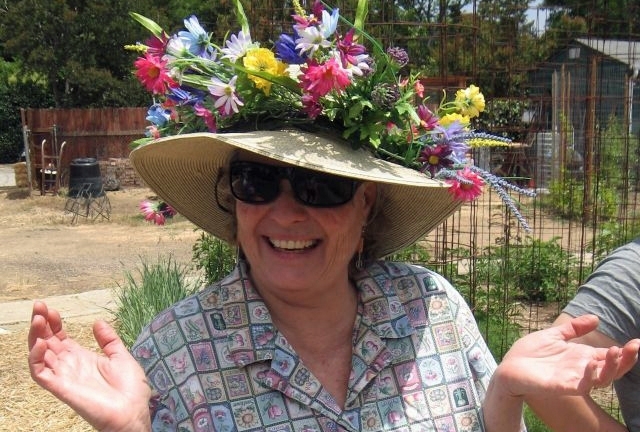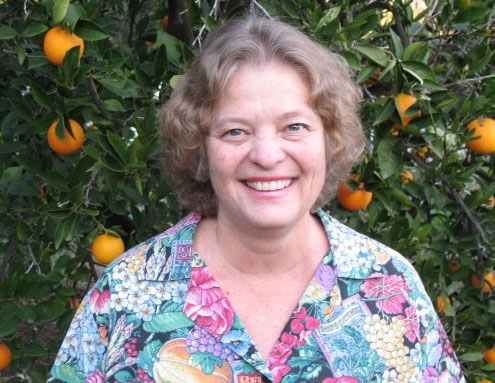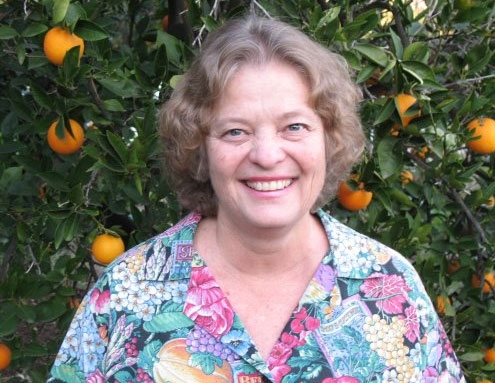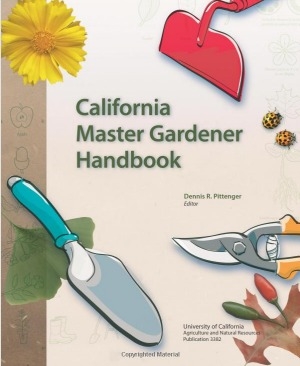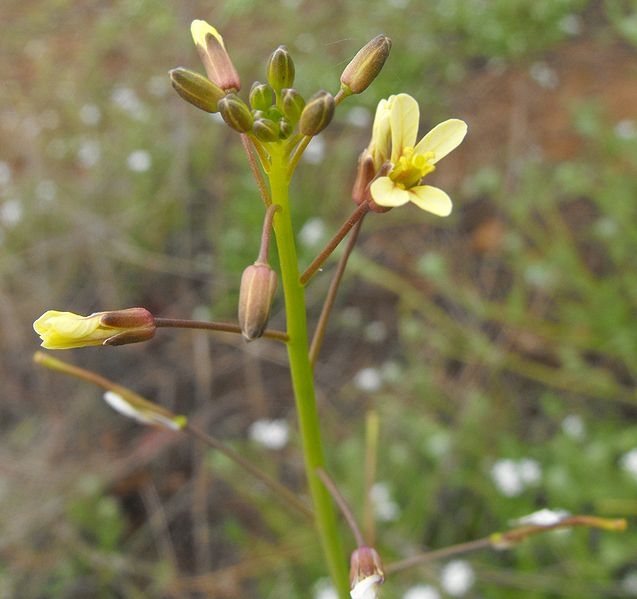Posts Tagged: Yvonne Savio
Build the soil for successful gardening
Before digging in to spring planting, pay attention to building the soil, advises an article in the Los Angeles Times by Jeanette Marantos.
Marantos visited the Pasadena backyard garden of Yvonne Savio, the retired coordinator of the UC Master Gardener Program in Los Angeles County. Savio is the creator of the Gardening in LA blog, with new stories appearing "every other week or so."
“The old saying is, ‘Feed the soil, not the plant,'" Savio said. “When you just use chemical fertilizers, you're not establishing a long-lasting base of nutrition for the plant. It's just giving it a huge piece of cake on Sunday, and then by Thursday it's nutritionally starving.”
Savio recommends a steady diet of organic matter be spaded into soil, and a layer of organic mulch added to the top of soil.
When you continually add organic amendments to the soil, the dirt comes alive as the amendments decompose, creating the beneficial bacteria, fungi and the nutrients plants need to grow strong and healthy, Savio said. “It's really like a cafeteria where your plants can pick and choose what they really like.”
UC Master Gardeners in LA are volunteers who garden
Instead of recruiting gardeners interested in volunteering, Yvonne Savio decided to look for volunteers interested in gardening. The subtle change led to development of a UC Master Gardener program in Los Angeles County that is unique in the state of California, reported Jeff Spurrier in the LA Times.
UC Master Gardeners volunteer under the auspices of UC Agriculture and Natural Resources (UC ANR). UC ANR Cooperative Extension offices in 50 California counties operate the volunteer gardening education program.
Savio has served as the UC Master Gardener coordinator in LA County since 1994. The first few years of MG classes, the students were often retirees or garden club members, many of whom were uninterested in volunteering in areas where they was the greatest need. In 2000, Savio visited community garden to search for volunteers.
"That's what started this synergy between master gardeners and community gardens," she says. "We in L.A. are completely different from other [master gardener programs] statewide in that we allow people to develop their own projects. We have had the special distinction in specializing in edibles, school gardens and low-income folks. As much as we're known for doing this wonderful stuff, it's not within the purview of other master gardener programs."
The program will continue after Savio retires at the end of June with Rachel Surls, the UC ANR Cooperative Extension urban agriculture advisor, at the helm. In retirement, Savio be writing a blog at http://gardeninginLA.net with garden resources for the greater Los Angeles County area and beyond.
Turn a 'victory garden' into a 'vitamin garden'
"In Southern California, we can indeed turn gardens into vitamin patches," said Kari Walker, a UC Cooperative Extension Master Gardener volunteer in LA County. "It is not hard and you don't need a lot of space for a garden."
A registered dietician quoted in the story says fruit and vegetables' vitamin levels will be at their highest when eaten raw immediately after harvest.
"Nothing beats fruits and vegetables for digestion, sources of fiber and good nutrition," she said. "Mom is always right."
For a sidebar, Sproul turned to the coordinator of the UCCE Master Gardener Program in Los Angeles County, Yvonne Savio.
Savio suggested Southern California residents plant lima and snap beans, beets, carrots, celery, cucumbers, eggplants and other heat-tolerant and bolt-resistant lettuces, melons, okra, peppers, sweet potatoes, pumpkins, radishes, summer and winter squash, and tomatoes before the end of June.
Add more vitamins to the garden with herbs and spices. Savio suggested lavender, marjoram, rosemary, sage and thyme in sunny, dry areas. Basil, chives, coriander and parsley prefer richer soil with more frequent watering.
More details about planting, irrigating, feeding and harvesting a home garden in Southern California are on the LA County Master Gardeners website.
Five gift ideas from UCCE Master Gardeners
Who better to give advice on presents for gardeners but Master Gardeners certified by the University of California Cooperative Extension? asks Katherine Spiers this week in the KCET "In-Ground Gardens" blog.
The UC Master Gardener Program trains volunteers to extend research-based information to the public about home horticulture and pest management.
In the KCET story, a few UCCE Master Gardeners of Los Angeles County share their tips for excellent garden gifts.
- Master Gardener Denise Friese suggested rain barrels, which collect water when it rains so it can be used between storms for irrigation. "Plus, there is a new rebate for rain barrels from the Metropolitan Water District," she said.
- Master Gardener Elizabeth Ostrom recommended moisture meters. "It's an excellent tool that lets you know if you are under/over watering. And over time, it acts as a teaching tool," she said.
- Master Gardener Jane Auerbach suggested a gift membership to a garden club, which offers abundant inspiration and, often, free classes with membership.
- Auerbach also recommended Felco pruners, "the gold standard" in gardening equipment.
- Yvonne Savio, the Master Gardener coordinator in LA County, recommended the California Master Gardener Handbook. Written by UC academics, the 700-page handbook is a gardening encyclopedia.
Invasive weeds are taking a toll on wildflower displays
Sahara mustard, a resilient weed native to North Africa and the Mediterranean, is invading desert landscapes in the American Southwest, squeezing out beautiful wildflower displays that attract tourists and maintain the local ecology, reported the San Diego Union Tribune.
UC Cooperative Extension is testing methods of removing Sahara mustard, including hand weeding, hoes and herbicide. But these are only stopgap measures meant to keep the plant at bay in select spots.
“I don’t think we’re ever going to spray the herbicide across the entire Southwest,” said Chris McDonald, UCCE advisor in San Bernardino County. “But the idea is preserving areas of value, such as the wildflower fields of Borrego Springs.”
Sahara mustard has been in California since 1927, but it wasn't until Hurricane Kathleen doused California in 1976 that it proliferated widely, according to Rich Minnich, professor in the Department of Geography at UC Riverside.
“There was this gigantic explosion of mustard, and it’s never been the same since,” Minnich said.
Anza-Borrego's tough eradication project: Cutting the mustard
Louis Sahagun, Los Angeles Times
A front-page story in the Los Angeles Times detailed the changing attractions in Borrego Springs. Tourists used to come to see a colorful display of wildflowers, but because of an invasive weed, Sahara mustard, local officials are now trying to turn visitors attention to hiking, cycling, star gazing and photography instead. UCCE's Chris McDonald, who is conducting research on Sahara mustard control, was featured in four of the nine photos that accompanied the story.
Nutgrass: Three experts' solutions to one of the worst weeds
L.A. at Home blog, Los Angeles Times
Nutsedge is commonly considered a gardeners' worst enemy, which is further proven by the draconian measures to control the weed offered by UC and other experts in the L.A. at Home blog this week. In the introduction to the problem, Cheryl Wilen, UC Cooperative Extension advisor, notes there are two kinds of nutsedge. One way to tell them apart takes a little courage.
"If you are inclined to bite into one," she said, "yellow nutsedge has a pleasant almond or brazilnut taste, while purple nutsedge does not have a good flavor."
Controlling either kind is challenging. Yvonne Savio, UCCE manager of the L.A. County common ground program, suggests extricating the weed in a way that may seem extreme.
Dig 6 inches around and under each weed and throw the weed and dug up soil into the garbage. "Don't even think of composting the weed or filtering the soil through a screen," Savio said. The weeds will come back.


